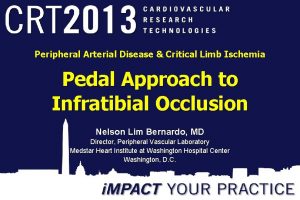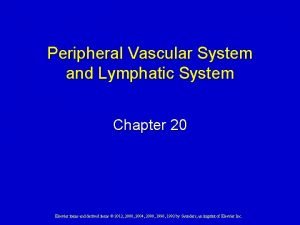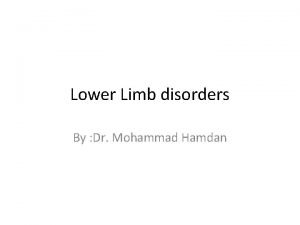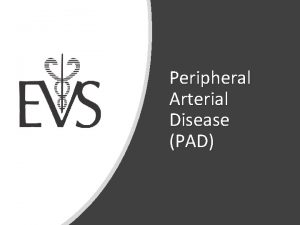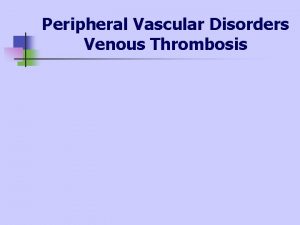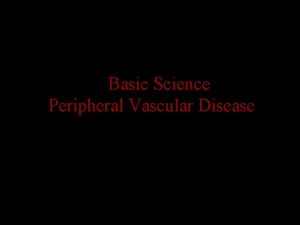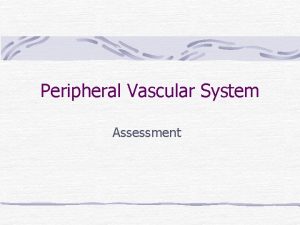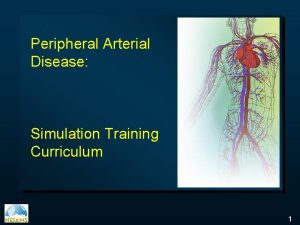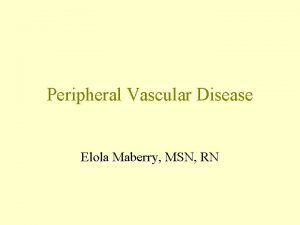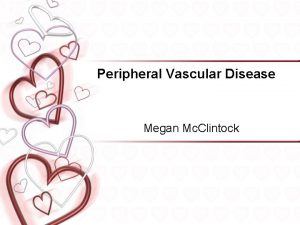Vascular Disorders Peripheral Arterial Disease of the Lower











- Slides: 11

Vascular Disorders Peripheral Arterial Disease of the Lower Extremities n Aortoiliac, femoral, popliteal, tibial, or peroneal arteries n Classic symptom: Intermittent Claudication n n Ischemic muscle ache precipitated by a consistent level of exercise Paresthesia – numbness / tingling in toes & feet Trophic changes: reactive hyperemia dependent rubor Rest pain – nocturnal

Peripheral Arterial Disease

Peripheral Arterial Disease of the Lower Extremities n Diagnostics: n Non-invasive: Doppler Studies n Invasive: Angiography

Peripheral Arterial Disease of the Lower Extremities n Treatment: n Risk Factor Modification – HTN – Stepped Approach to Control n Smoking - Cessation n Treatment of hyperlipidemia - Nutrition n Exercise – slow progressive walking n n Medication – Antiplatelet Therapy – Plavix / ASA n < blood viscosity / >erythrocyte flexibility – Trental n < platelet aggregation & promote vasodilation - Pletal n

Peripheral Arterial Disease of the Lower Extremities n Critical Limb Ischemia n Interventional Radiology n n n Surgical Revascularization n n Percutaneous transluminal balloon angioplasty Atherectomy Endarterectomy Graft angioplasty Peripheral artery bypass surgery End-stage surgery - amputation

Vascular Disorders Peripheral Arterial Disease of the Lower Extremities n Nursing Diagnoses Ineffective tissue perfusion n Impaired skin integrity n Acute pain n Activity intolerance n Ineffective therapeutic management n

Peripheral Arterial Disease of the Lower Extremities n n n Assess: Peripheral pulses, pallor, blanching, hyperemia, warmth, capillary refill, ability to bear weight and walk, pain, risk factors Nsg Action: Medication administration, prepare for tests, treatment, surgery, prevent injury, skin care, community referrals Pt/Family Education: Skin care, Medications, risk factor modification, exercise

Peripheral Vascular Disease Thromboangiitis Obliterans Buerger’s Disease n Nonathersclerotic, segmental inflammation of arteries, veins & nerves of upper and lower extremities More common in men 25 -40 years of age n Correlates with cigarette smoking n Rest pain, ischemic ulcerations n Tx: smoking cessation / medications – anti-platelets, vasodilators n Surgical: Amputation n

Peripheral Disease Clinical Manifestations

Peripheral Vascular Disease Treatment

Peripheral Vascular Disease Raynaud’s Phenomenon n Episodic vasospastic disorder of small cutaneous arteries in fingers & toes n n n Cause: Exaggerated SNS stimulation Occurs in women 15 -40 years of age May occur with collagen diseases: RA, scleroderma, systemic lupus erythematosus Vasospasm Phase: Blanching of hands & fingers with throbbing, aching pain, numbness, tingling Hyperemic Phase: swelling n Tx: Smoking Cessation, no meds with vasoconstrictive effect; avoid cold; avoid constrictive clothes; Give Calcium-channel blockers
 Peripheral arterial disease
Peripheral arterial disease Vascular cambium function
Vascular cambium function Non vascular plants
Non vascular plants Non vascular plant
Non vascular plant Vascular and non vascular difference
Vascular and non vascular difference Peripheral arterial pulse sites
Peripheral arterial pulse sites Peripheral vascular system
Peripheral vascular system Lower limb disorders
Lower limb disorders Communicable disease and non communicable disease
Communicable disease and non communicable disease Thế nào là hệ số cao nhất
Thế nào là hệ số cao nhất Sơ đồ cơ thể người
Sơ đồ cơ thể người Tư thế ngồi viết
Tư thế ngồi viết
